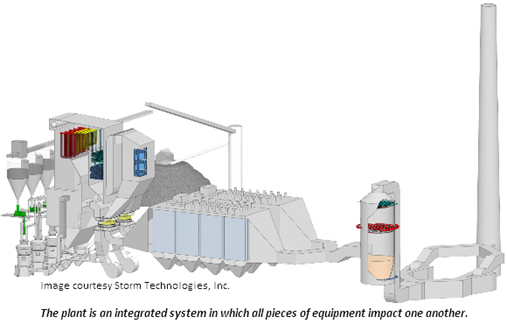Process Influences & Keys to Performance
The different areas of a power utility or industrial plant are sometimes operated as if they’re isolated from one another, when in fact every piece of equipment in the system eventually impacts every other piece of equipment. This section looks at some of the ways front-end operations (mills, boiler) impact the performance of electrostatic precipitators on the back end.
Flue gas volume, temperature and composition, as well as particulate size and composition, is largely determined by how well combustion equipment is operated and maintained. These two sets of factors have a direct, significant impact on a plant’s ability to comply with air pollution limits set by Federal and state regulators. Gas characteristics and particle properties define how well a precipitator will work in a given application. The main process variables to consider are:
- Gas Flow Rate¨ “ The gas flow rate in a power plant is defined by coal quality, boiler load, excess air rate and boiler design. Where there is no combustion, the gas flow rate will have process-specific determinants. A precipitator operates best with a gas velocity of 3.5 – 5.5 ft/sec. At higher velocity, particle re-entrainment increases rapidly. If velocity is too low, performance may suffer from poor gas flow distribution or from particle dropout in the ductwork.
- Particle Size¨ “ The size distribution in a power plant is defined by coal quality, the coal mill settings and burner design. Particle size for non-combustion processes will have similar determinants. A precipitator collects particles most easily when the particle size is coarse. The generation of the charging corona in the inlet field may be suppressed if the gas stream has too many small particles (less than 1 µm). ¨Very small particles (0.2 – 0.4µm) are the most difficult to collect because the fundamental field-charging mechanism is overwhelmed by diffusion charging due to random collisions with free ions.
- Particle Resistivity¨ “ Resistivity is resistance to electrical conduction. The higher the resistivity, the harder it is for a particle to transfer its electrical charge. Resistivity is influenced by the chemical composition of the gas stream, particle temperature and gas temperature. Resistivity should be kept in the range of 108 – 1010 ohm-cm. ¨High resistivity can reduce precipitator performance. For example, in combustion processes, burning reduced-sulfur coal increases resistivity and reduces the collecting efficiency of the precipitator. Sodium and iron oxides in the fly ash can reduce resistivity and improve performance, especially at higher operating temperatures. ¨On the other hand, low resistivity can also be a problem. For example (in combustion processes), unburned carbon reduces precipitator performance because it is so conductive and loses its electrical charge so quickly that it is easily re-entrained from the collecting plate.
- Gas Temperature¨ “ The gas temperature is affected by heat transfer efficiency in the boiler as well as the air-preheater efficiency and air in-leakage. The effect of gas temperature on precipitator collecting efficiency, given its influence on particle resistivity, can be significant.
Helpful Resources:
KnowledgeBase: Improve Flow Distribution
KnowledgeBase: Optimize Corona Power
KnowledgeBase: Reduce ReEntrainment
Our Capabilities: Asset Lifecycle Management
Our Capabilities: Analytical & Lab Services
Our Capabilities: Predictive Modeling




